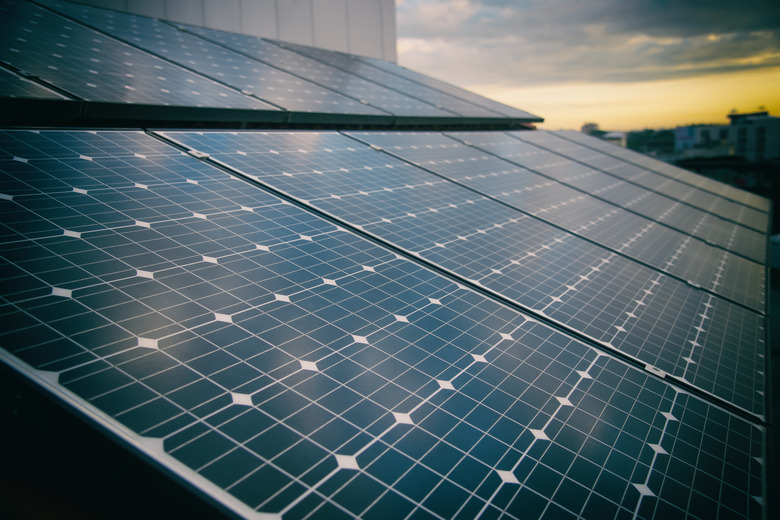The Output Watts Of Solar Panels
Solar panels are made up of a number of individual solar cells. The properties of these cells determines the overall maximum power of the entire panel. The electrical power that solar panels generate is measured in watts. Each solar panel has a listed rating of output watts based on its power output under specific sunlight conditions.
Power Ratings and Panel Efficiency
Power Ratings and Panel Efficiency
The solar energy available to solar panel systems depends on a number of factors. Latitude, weather and the angle of incoming sunlight each affect the amount of solar energy available at a location. However, in order to rate solar panels for comparison, manufacturers assume an average available solar energy of 1,000 watts per square meter. The percentage of that energy that is converted into electrical energy is the panel's efficiency. For example, a 1-square-meter panel might have a power output rating of 150 watts. Assuming 1,000 available watts, this panel converts 15 percent of that solar energy into electrical energy. Therefore, this panel has an efficiency of 15 percent. The average silicon solar panel produces power at roughly 15 to 18 percent efficiency, depending on silicon crystal type.
Characteristics of Solar Cells
Characteristics of Solar Cells
The power output of a solar panel depends on the voltage and current generated by its individual cells. Voltage is the electrical potential difference between two points and is measured in volts. Current is the measurement of the flow of electric charge through a given area and is measured in amps. A typical silicon solar cell generates between 0.5 and 0.6 volts. The output current varies depending on the size of the cell. In general, a typical commercially-available silicon cell produces a current between 28 and 35 milliamps per square centimeter. When cells are combined, current and voltage can be increased. Power is the product of voltage and current. Therefore, larger modules will have larger output watt ratings.
Cell Connections
Cell Connections
Cells can be connected in either series or parallel connections. Series connections consist of cells connected end to end. When cells are connected in series, their voltages add but their currents do not; the current of a series connection is the same as one cell. For example, two cells that produce 0.6 volts connected in series would produce 1.2 volts. However, the current would not increase. Parallel connections consist of cells connected side by side. When cells are connected in parallel, their currents add, but their voltages do not. You can combine these two types of connections in order to obtain nearly any combination of voltage and current, resulting in a wide variety of output power ratings.
Shading and Output Watts
Shading and Output Watts
If solar panels are shaded directly or receive a reduced amount of sunlight, their current decreases. Therefore, they will produce a lower amount of power. If a shaded cell is connected in series with other cells, the overall current of the series connection is limited to that of the shaded cell. In extreme cases, this power imbalance can damage a solar panel. For this reason, panels are typically equipped with components called bypass diodes, which redirect the flow of current around shaded or impaired cells.
Cite This Article
MLA
Murmson, Serm. "The Output Watts Of Solar Panels" sciencing.com, https://www.sciencing.com/output-watts-solar-panels-6946/. 9 March 2018.
APA
Murmson, Serm. (2018, March 9). The Output Watts Of Solar Panels. sciencing.com. Retrieved from https://www.sciencing.com/output-watts-solar-panels-6946/
Chicago
Murmson, Serm. The Output Watts Of Solar Panels last modified March 24, 2022. https://www.sciencing.com/output-watts-solar-panels-6946/
